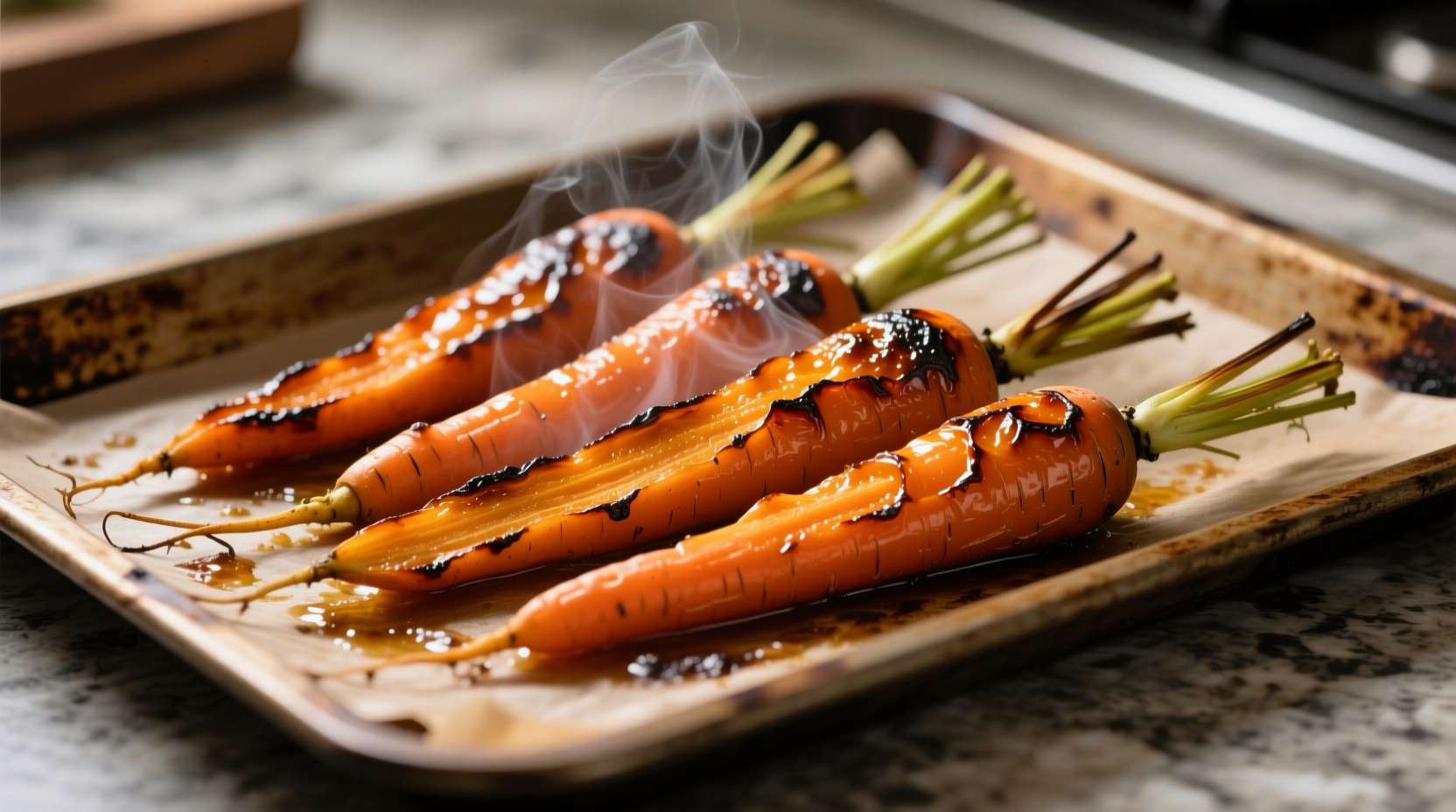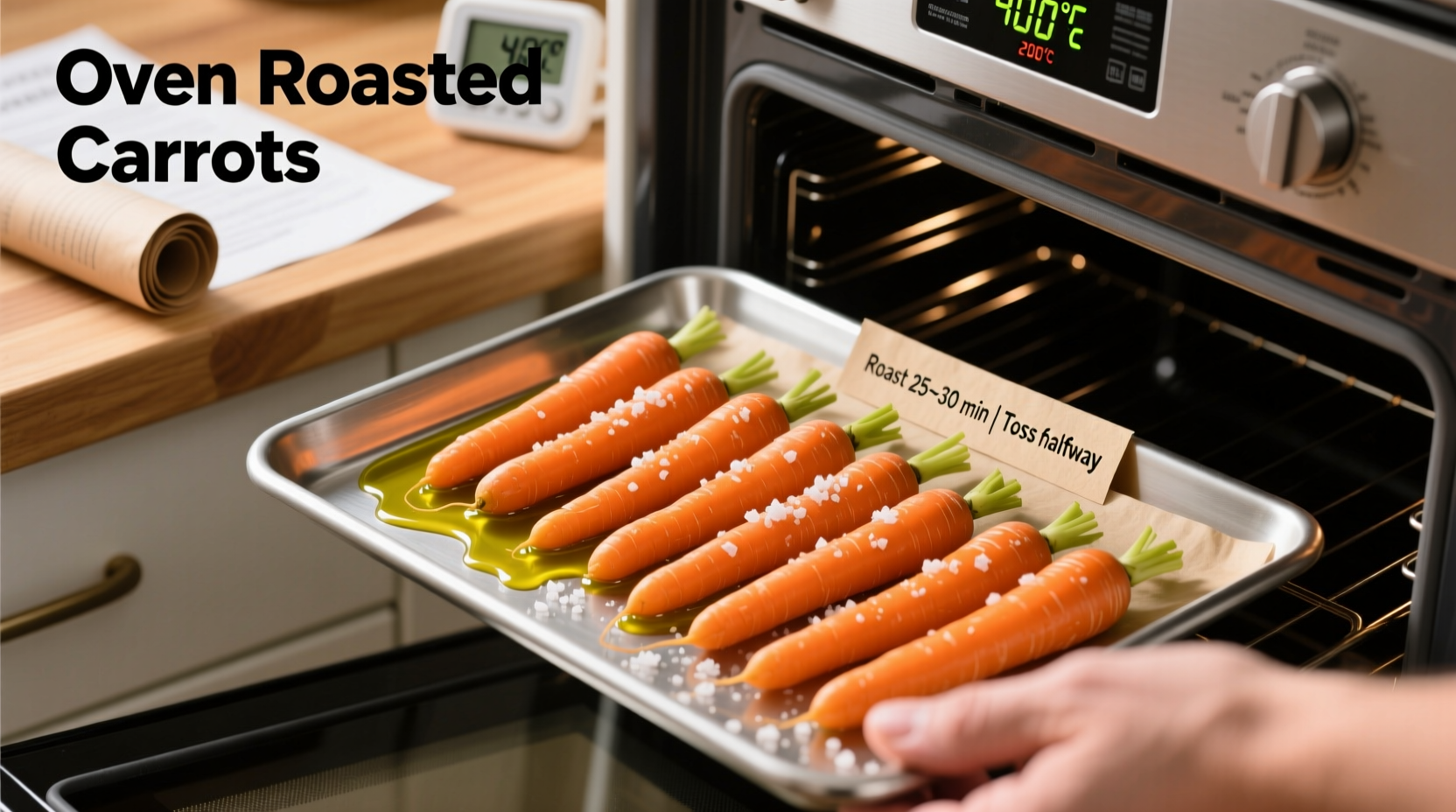The perfect method for oven-cooked carrots involves preheating your oven to 400°F (200°C), tossing peeled and cut carrots with 1-2 tablespoons of olive oil, salt, and pepper, then roasting on a parchment-lined baking sheet for 25-35 minutes until fork-tender with caramelized edges. This dry-heat method enhances natural sweetness through caramelization while preserving more nutrients than boiling.
Discover why professional chefs consistently choose oven-roasting over boiling for carrots. This comprehensive guide delivers precise temperature control, timing variations for different carrot sizes, and flavor-enhancing techniques that transform this humble vegetable into a showstopper side dish. Whether you're a beginner cook or looking to refine your kitchen skills, you'll master oven-roasted carrots with confidence.
Why Oven-Roasting Beats Boiling for Carrots
Food science confirms that oven-roasting carrots at high temperatures triggers the Maillard reaction and caramelization, creating complex flavor compounds that boiling simply cannot achieve. According to research from the USDA Food Research Laboratory, roasting preserves up to 25% more beta-carotene than boiling, as water-soluble nutrients aren't leached into cooking water.
| Cooking Method | Nutrient Retention | Flavor Development | Texture Result |
|---|---|---|---|
| Oven Roasting | High (20-25% more beta-carotene) | Excellent caramelization | Firm-tender with crispy edges |
| Boiling | Moderate (nutrients leach into water) | Minimal flavor development | Uniform softness |
| Steaming | Good (minimal nutrient loss) | Mild flavor enhancement | Even tenderness |
Essential Equipment and Ingredient Selection
Start with fresh, firm carrots that feel heavy for their size. The University of Minnesota Extension recommends choosing carrots with bright orange color and smooth skin for optimal roasting results. For equipment, you'll need:
- Heavy-duty rimmed baking sheet (prevents warping at high temps)
- Parchment paper (creates non-stick surface without excess oil)
- Sharp chef's knife (for uniform cutting)
- Metal spatula (for easy flipping)
Professional chefs consistently use extra-virgin olive oil for its smoke point (375-420°F) that perfectly matches carrot roasting temperatures. For sweeter varieties, try avocado oil which has a higher smoke point (520°F) for longer roasting times.
Step-by-Step Roasting Process
Follow this precise timeline for perfect oven-cooked carrots every time:
- Preparation (5 minutes): Peel carrots and cut into uniform 2-3 inch sticks. For baby carrots, leave whole but trim ends.
- Preheat (15 minutes): Set oven to 400°F (200°C) with rack in center position.
- Tossing (2 minutes): In large bowl, combine carrots with 1-2 tbsp oil, ½ tsp salt, and freshly ground pepper.
- Arrangement (3 minutes): Spread in single layer on parchment-lined baking sheet with space between pieces.
- Roasting (25-35 minutes): Roast until fork-tender with caramelized edges, flipping halfway through.
Timing varies based on carrot thickness:
- Thin sticks (¼ inch): 20-25 minutes
- Medium sticks (½ inch): 25-30 minutes
- Thick sticks (¾ inch): 30-35 minutes
- Baby carrots: 25-30 minutes
The critical visual indicator is when carrots develop deep golden-brown edges while remaining tender when pierced with a fork. Overcooking leads to mushiness, while undercooking leaves them too firm.

Flavor Variations for Every Palate
Elevate your basic roasted carrots with these chef-approved variations that work within the standard cooking time:
Classic Herb Roasted Carrots
Add 1 tablespoon fresh thyme or rosemary leaves and 2 minced garlic cloves to the oil mixture before roasting. The herbs release essential oils during cooking, creating aromatic complexity without burning.
Honey-Glazed Carrots
Mix 2 tablespoons honey with the oil before tossing with carrots. For food safety, the FDA recommends adding acidic elements like 1 teaspoon lemon juice to prevent crystallization and balance sweetness.
Spiced Carrot Medley
Combine ½ teaspoon each of cumin and smoked paprika with the oil. The dry spices toast during roasting, developing deeper flavor notes than if added after cooking.
Troubleshooting Common Roasting Issues
Even experienced cooks encounter these challenges. Here's how to fix them:
Soggy Carrots
Cause: Overcrowded baking sheet creating steam Solution: Use two baking sheets if needed, ensuring space between carrot pieces for proper air circulation
Burnt Edges
Cause: Oven temperature too high or carrots cut unevenly Solution: Reduce temperature to 375°F (190°C) and cut carrots to uniform thickness
Uneven Cooking
Cause: Inconsistent flipping during roasting Solution: Set timer to flip carrots at 15-minute intervals for even browning
Serving and Storage Tips
For maximum flavor impact, finish roasted carrots with a squeeze of fresh lemon juice or a sprinkle of flaky sea salt immediately after removing from the oven. The American Heart Association notes that adding acid after cooking helps preserve vitamin C content.
Store leftovers in an airtight container in the refrigerator for up to 4 days. Reheat in a 350°F (175°C) oven for 10-15 minutes to restore texture—microwaving makes them soggy. Frozen roasted carrots maintain quality for up to 3 months but work best in soups or stews after thawing.
Perfect Pairings for Oven-Roasted Carrots
These versatile roasted carrots complement various main courses:
- With poultry: Pair with roasted chicken and thyme for a classic combination
- With fish: Serve alongside salmon with a lemon-dill sauce
- Vegan meals: Combine with quinoa and chickpeas for a complete protein
- Holiday meals: Add orange zest and pomegranate seeds for festive presentation
Professional chefs emphasize that the natural sweetness of roasted carrots balances well with savory or acidic components. When planning your meal, consider how the caramelized notes will interact with other elements on your plate.
Frequently Asked Questions
Can I roast carrots without peeling them?
Yes, thoroughly scrubbed unpeeled carrots work well for roasting. The skin contains additional fiber and nutrients, but may result in slightly tougher texture. For baby carrots or young spring carrots, leaving the skin on enhances visual appeal and nutritional value.
Why are my roasted carrots still hard after 30 minutes?
This typically happens when carrots are cut too thickly or the oven temperature is inaccurate. Use an oven thermometer to verify temperature, and cut carrots to uniform ½-inch thickness. Larger carrots may need 35-40 minutes at 400°F (200°C) to become fully tender while developing caramelized edges.
Should I cover carrots when roasting in the oven?
No, always roast carrots uncovered. Covering creates steam that prevents proper caramelization and leads to boiled rather than roasted texture. The dry heat environment is essential for developing the characteristic golden-brown edges and concentrated sweetness that make oven-roasted carrots superior to other cooking methods.
Can I roast carrots with other vegetables?
Yes, but consider cooking times. Pair carrots with vegetables having similar roasting requirements like parsnips, sweet potatoes, or beets. Add quicker-cooking vegetables like zucchini or bell peppers during the last 10-15 minutes. The key is arranging vegetables by density—place denser vegetables like carrots on one side of the pan and quicker-cooking items on the other.











 浙公网安备
33010002000092号
浙公网安备
33010002000092号 浙B2-20120091-4
浙B2-20120091-4